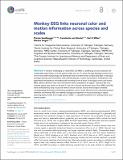| dc.contributor.author | Sandhaeger, Florian | |
| dc.contributor.author | Von Nicolai, Constantin | |
| dc.contributor.author | Miller, Earl K | |
| dc.contributor.author | Siegel, Markus | |
| dc.date.accessioned | 2020-04-30T21:34:10Z | |
| dc.date.available | 2020-04-30T21:34:10Z | |
| dc.date.issued | 2019-07 | |
| dc.date.submitted | 2019-01 | |
| dc.identifier.issn | 2050-084X | |
| dc.identifier.uri | https://hdl.handle.net/1721.1/124966 | |
| dc.description.abstract | It remains challenging to relate EEG and MEG to underlying circuit processes and comparable experiments on both spatial scales are rare. To close this gap between invasive and non-invasive electrophysiology we developed and recorded human-comparable EEG in macaque monkeys during visual stimulation with colored dynamic random dot patterns. Furthermore, we performed simultaneous microelectrode recordings from 6 areas of macaque cortex and human MEG. Motion direction and color information were accessible in all signals. Tuning of the non-invasive signals was similar to V4 and IT, but not to dorsal and frontal areas. Thus, MEG and EEG were dominated by early visual and ventral stream sources. Source level analysis revealed corresponding information and latency gradients across cortex. We show how information-based methods and monkey EEG can identify analogous properties of visual processing in signals spanning spatial scales from single units to MEG - a valuable framework for relating human and animal studies. | en_US |
| dc.description.sponsorship | National Institute of Mental Health (U.S.) (Grant R37MH087027) | en_US |
| dc.language.iso | en | |
| dc.publisher | eLife Sciences Publications, Ltd | en_US |
| dc.relation.isversionof | http://dx.doi.org/10.7554/eLife.45645 | en_US |
| dc.rights | Creative Commons Attribution 4.0 International license | en_US |
| dc.rights.uri | https://creativecommons.org/licenses/by/4.0/ | en_US |
| dc.source | eLife | en_US |
| dc.title | Monkey EEG links neuronal color and motion information across species and scales | en_US |
| dc.type | Article | en_US |
| dc.identifier.citation | Sandhaeger, Florian, et al. “Monkey EEG Links Neuronal Color and Motion Information across Species and Scales.” ELife 8 (July 2019): e45645. © 2019 Sandhaeger et al. | en_US |
| dc.contributor.department | Massachusetts Institute of Technology. Department of Brain and Cognitive Sciences | en_US |
| dc.contributor.department | Picower Institute for Learning and Memory | en_US |
| dc.relation.journal | ELife | en_US |
| dc.eprint.version | Final published version | en_US |
| dc.type.uri | http://purl.org/eprint/type/JournalArticle | en_US |
| eprint.status | http://purl.org/eprint/status/PeerReviewed | en_US |
| dc.date.updated | 2019-10-03T14:25:24Z | |
| dspace.date.submission | 2019-10-03T14:25:26Z | |
| mit.journal.volume | 8 | en_US |
| mit.metadata.status | Complete | |
